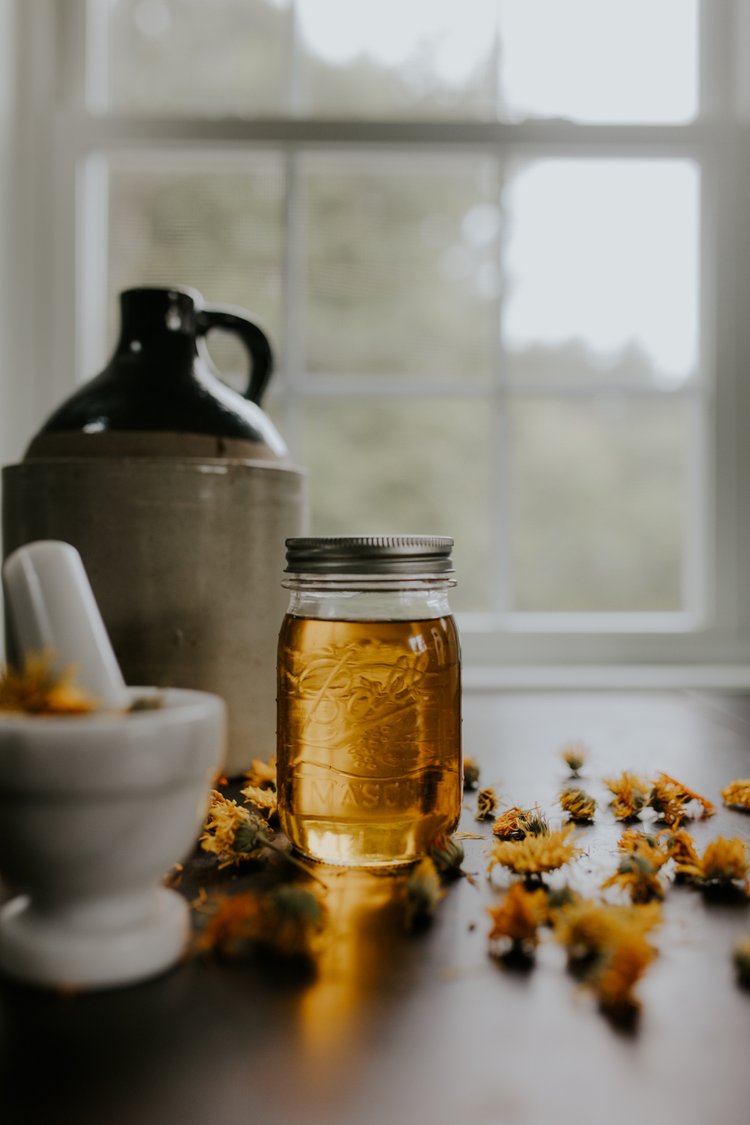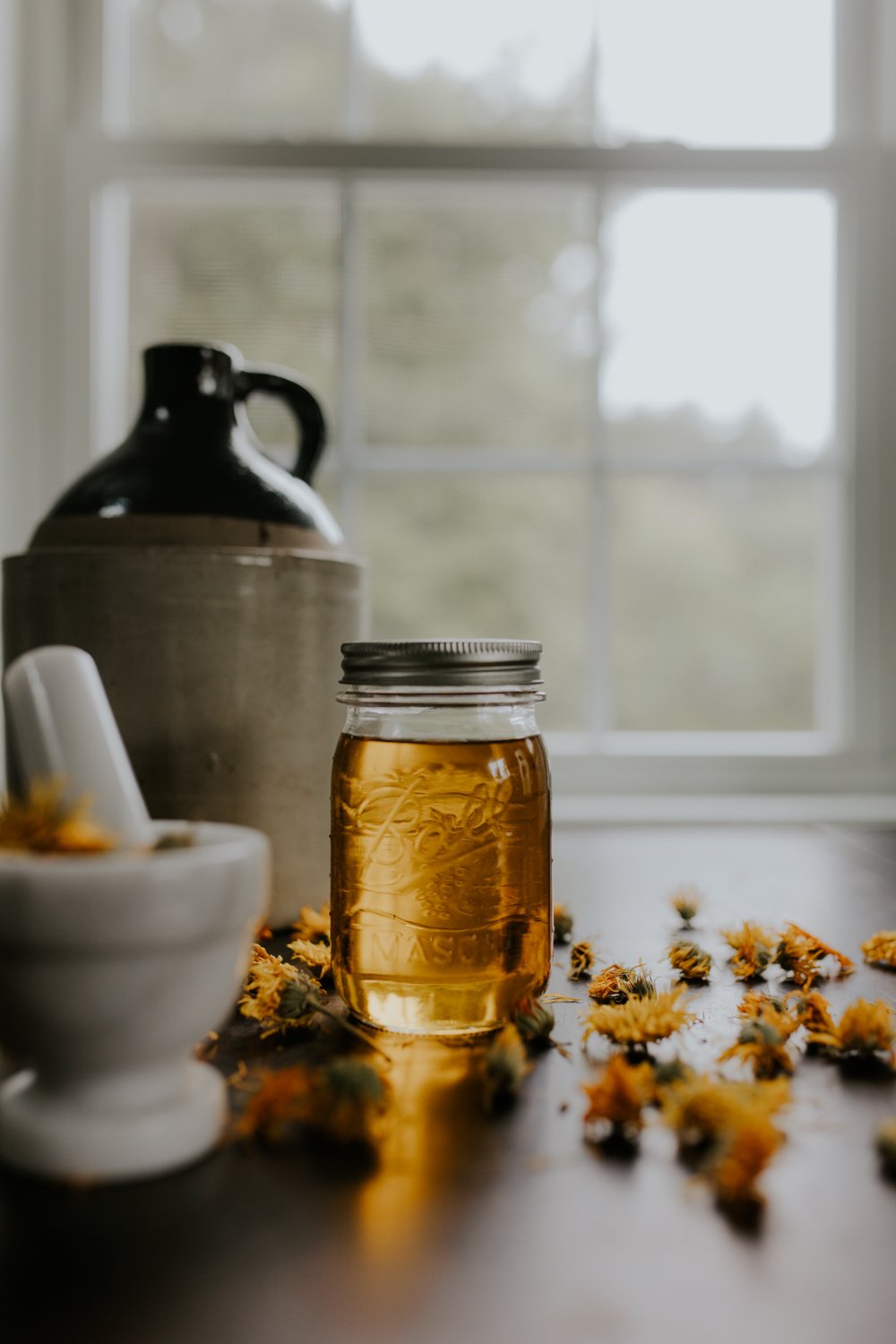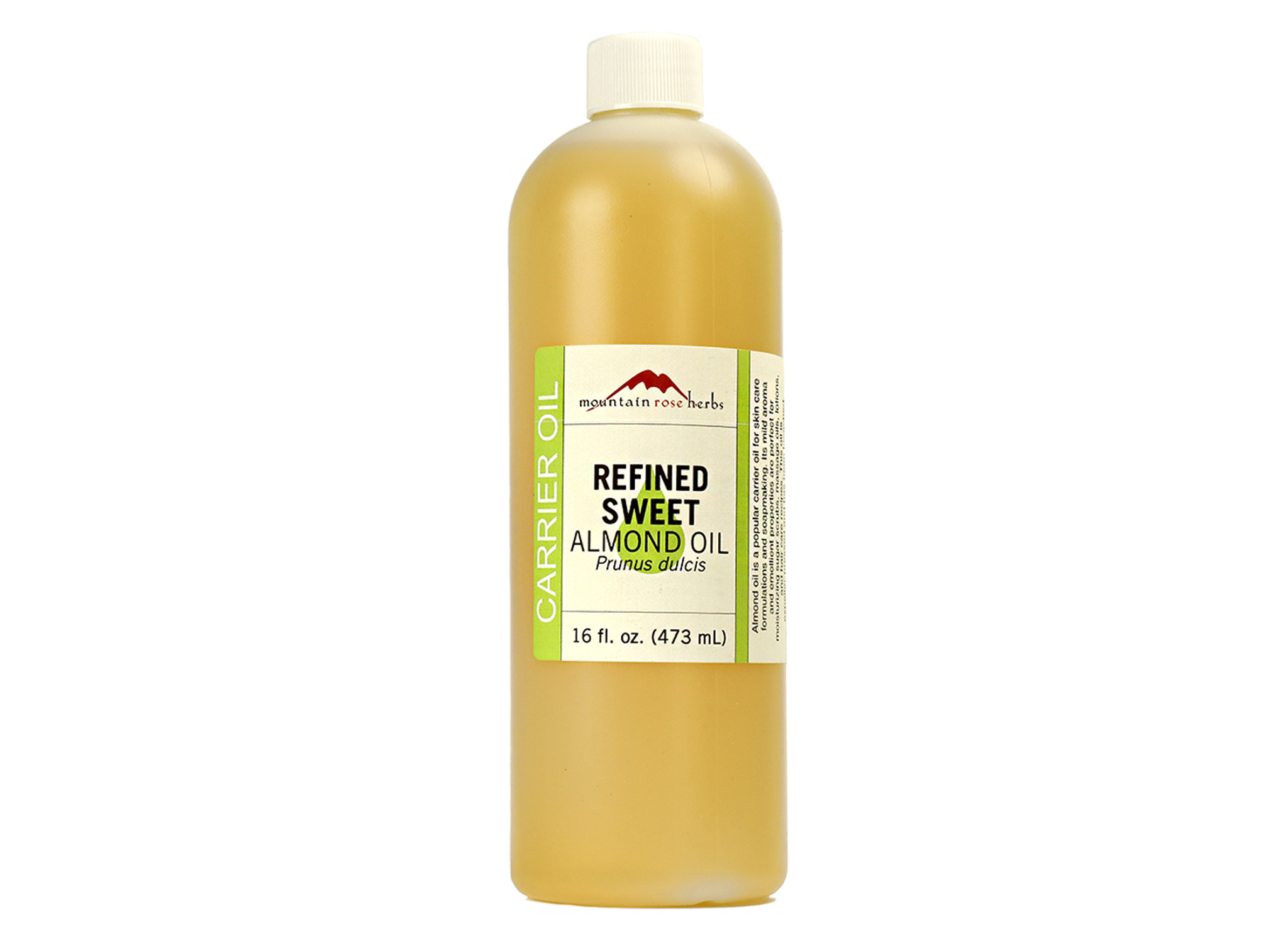Who can benefit from Calendula infused oil? [recipe]
If you’re looking to dip your toes into herbal remedies, calendula infused oil is a safe and fun place to start. Calendula is related to marigolds and is sometimes called pot marigold - it has no toxic look-a-likes and is safe even in large doses, so you really can’t mess this up! We grow calendula in our garden as a border and it serves multiple purposes for us - it adds beauty and color, traps unwanted pests who might overwise eat our food crop, feeds the pollinators and provides a useful herb for drying that we can then make into a salve. Calendula is an annual but it readily self-seeds so you really only need to buy one packet and the next year they will come back all on their own, helping you to establish your garden beds and provide a resource for neighboring insects who you share your garden with.
So what are some calendula oil benefits? Calendula is…
Antifungal
Antimicrobial
Anti-inflammatory
Antioxidant
These properties and more are the reason people use calendula to prevent infection and heal injuries to body tissues, speed up wound healing time, and reduce scarring. In addition when used as part of a wound treatment it may reduce swelling and bruising and ease muscle fatigue. Calendula may also help in preventing or reducing acne. Calendula is used to relieve symptoms from dry skin conditions like eczema, psoriasis and diaper rash. There’s even a chance calendula could be used to fight cancer and protect against heart disease.
On a personal note, psoriatic arthritis doesn’t just affect my joints. It actually started for me as a skin condition with extremely dry itchy skin that cracks and flakes. I’ve felt so self conscious about my skin condition for so long, and want to normalize this struggle which so many of us with chronic illness go through. So often the more minor symptoms of our disease are tossed to the side as insignificant, but all these little insecurities add up. Needless to say this has been quite unpleasant, and a big reason that I began exploring natural remedies like this infused calendula oil was that I found my skin was really sensitive to the ingredients in most drugstore moisturizers and lotions. I wanted to find a way to make my own moisturizer that was simple and cost effective, and calendula oil was one of the very first DIY skincare products I made at home myself. I use my salve as a preventative product, as well as for acute flares. I just love really easy DIY projects like this one that anyone can do!
Calendula oil or salve makes a pretty great handmade holiday gift too! For the holidays last year I gave a tin of handmade calendula salve to every one of my friends tied up with a piece of twine and ribbon, and they all continue to rave about it and ask for more to this day.
Is Marigold the Same as Calendula?
Marigold and calendula belong to the same family, but the active beneficial compounds are present in different amounts in each plant, and only certain types of marigolds are edible.
How to Use Calendula Oil
Calendula oil may be used on its own as a moisturizing oil, or blended into butters, creams, salves and lotions along with other ingredients like beeswax and shea butter. I make a simple beeswax salve with my calendula oil that can be used for burns, cuts, scrapes, bruises, rashes and dry skin. You can even incorporate it into your favorite salad dressing depending on what oil you use (make sure it’s food grade)
What Type of Oil is Best for Infusing Herbs?
You can use many different oils to infuse herbs depending on your preference, budget and intended use. I used sweet almond oil for this herbal oil infusion, but olive oil, grapeseed oil and apricot oil also will work as carrier oils safe for topical use. Olive oil is by far the cheapest and most easy to find, and has a longer shelf life, but sweet almond oil is affordable as well and has no smell, plus it includes vitamin E and K. Both are good options that I use regularly! I haven’t tried grapeseed or apricot oil myself.
Best Container for Herbal Infusions
When infusing herbs in oil, you should always choose a plastic free container to avoid leaching any dangerous chemicals into your oil. I like to use a glass mason jar to infuse my oil since we always have so many extra on hand and they are durable and cheap, but if you don’t have somewhere dark you can store a clear jar, then a tinted glass jar or bottle is best to keep out sunlight, since UV rays can reduce the effectiveness and longevity of your infused oils.
Homegrown VS Store Bought Herbs
Store bought herbs don't just look different, they ARE different. So why are homegrown herbs better for you?
Think about the difference between a bagged, pre-chopped salad and the lettuce you picked up from the farmers market.
They're both still lettuce, but one is darker, fresher, and much more flavorful.
That flavor directly translates to compounds in the plant that are nutritionally dense. It tastes better because it's better for you! The older the produce is, the more those nutrients break down.
Herbs are the same way. When you get store bought herbs, there is almost no way to guarantee their freshness or quality. Yes, even dried herbs can be fresh! It's likely that if you're seeing faded colors or a lot of dust in your herbs indicating it's begun to break down, the beneficial compounds within the herbs themselves are not potent anymore.
Growing your own herbs (here’s my favorite place to buy calendula seeds) or buying from a small herbalist shop is the best way to ensure the quality of your final herbal preparation. It also eliminates the great amount of waste and emissions involved in packaging and shipping herbs, since even though many herbs like calendula grow all over the country, when you purchase them from a large store they often come from overseas. If you can’t grow your herbs yourself or find a small local shop: Find these herbs and more by tapping here to visit my favorite online herb shop!
How to Make Calendula Infused Oil
There are many ways to make an infused oil but my favorite is a simple folk method - this means we won’t be making any exact measurements. You’ll find that many herbalists employ a folk method for their skincare concoctions since accuracy in dosing is not generally a requirement unless taken internally.
To make an infused oil using the folk method, all you need to do is fill your mason jar about halfway with calendula flowers, then cover at least an inch above the herbs with your oil of choice. I usually end up filling the jar almost all the way to the top. Tap lightly on a solid surface to make sure there are no air bubbles trapped in the oil and place the infusing oil jar in a cool dark place such as a closet or pantry (somewhere out of direct sunlight) for about six weeks. You can regularly shake the jar to redistribute the oil, and you may notice that after the first day or two much of the oil has been absorbed into the dried herbs and you will need to add more to keep the flowers completely covered in oil. This is normal and to be expected.

Infused Calendula Oil
Ingredients
- Dried calendula flowers - about 1 cup
- Almond oil, grapeseed oil, apricot oil or olive oil - about 2 cups
Instructions
- To make an infused oil using the folk method, all you need to do is fill your mason jar about halfway with calendula flowers, then cover at least an inch above the herbs with your oil of choice.
- I usually end up filling the jar almost all the way to the top.
- Tap lightly on a solid surface to make sure there are no air bubbles trapped in the oil and place the infusing oil jar in a cool dark place such as a closet or pantry (somewhere out of direct sunlight) for about six weeks.
- You can regularly shake the jar to redistribute the oil, and you may notice that after the first day or two much of the oil has been absorbed into the dried herbs and you will need to add more to keep the flowers completely covered in oil. This is normal and to be expected.
- If you would rather not wait a full six weeks to have ready to use infused oil, you can speed up the infusion process using your stove top. Place your jar in a double boiler on your stove and simmer as low as possible for up to 3 hours.
- Your oil will be ready to use as soon as it cools, or you can wait a couple of weeks to allow your infusion to develop and grow stronger.
- You can also simmer your jar in a slow cooker for 3 hours the same way.
Notes
Some herbalists allow their oil to infuse on a sunny windowsill - personally I am against this method in most cases as it causes the oil to be exposed to large amounts of ultraviolet light which can break down the beneficial compounds. It may be fine if you plan to immediately move the jar to dark storage once it is done, or if you allow it to infuse only a couple of weeks on the windowsill before moving to a darker spot to finish infusing.
If you would rather not wait a full six weeks to have ready to use infused oil, you can speed up the infusion process using your stove top. Place your jar in a double boiler on your stove and simmer as low as possible for up to 3 hours. Your oil will be ready to use as soon as it cools, or you can wait a couple of weeks to allow your infusion to develop and grow stronger. You can also simmer your jar in a slow cooker for 3 hours the same way.
Some herbalists allow their oil to infuse on a sunny windowsill - personally I am against this method in most cases as it causes the oil to be exposed to large amounts of ultraviolet light which can break down the beneficial compounds. It may be fine if you plan to immediately move the jar to dark storage once it is done, or if you allow it to infuse only a couple of weeks on the windowsill before moving to a darker spot to finish infusing.
Ways to use calendula oil
After your oil is finished infusing, you can incorporate it into many different salves, balms, butters, creams and other skincare products. I hope this has shown you all the amazing benefits of calendula oil! It’s so easy to make an herb infused oil like this. I hope you’ll give it a try.









![The Power of Nature: How To Make Infused Oregano Oil for Your Health and Wellness [Recipe]](https://images.squarespace-cdn.com/content/v1/60e85024dc86d643da81c96a/1682625337753-AFI1M6MRRMDQ5CBNY2TX/unsplash-image-Fl2Ki3_GZIU.jpg)
![Make This Easy + Natural Botanical Hand Salve [Recipe]](https://images.squarespace-cdn.com/content/v1/60e85024dc86d643da81c96a/b57698b0-de70-4101-afaf-7af57788237d/Herbal+Face+Steam+Recipe+by+The+Cottage+Peach-1.jpg)